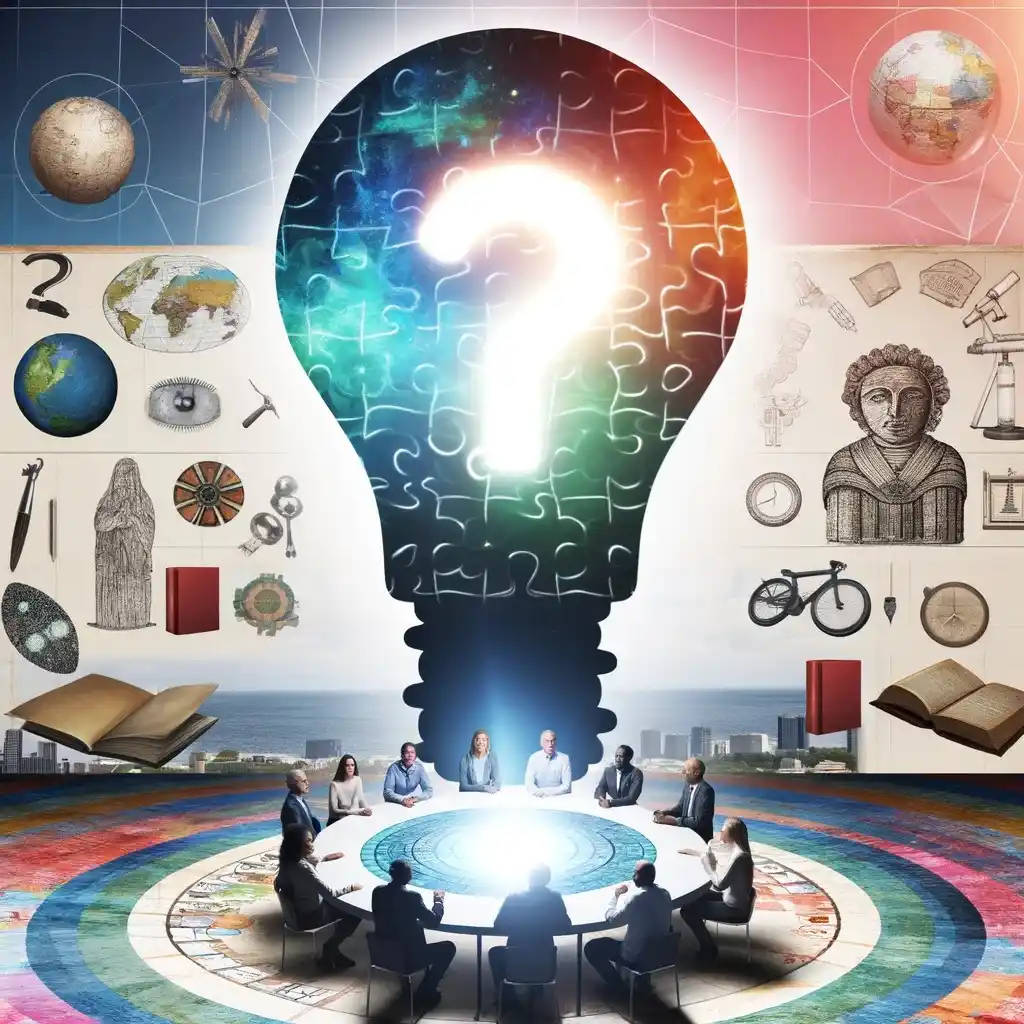This post has a comprehensive coverage of 6928 words content:
Table of contents
- The meaning and definition of Explanation through specific theories
- Explanation in different AOKs
- Relevant knowledge questions (KQs) on Eplanation
- Discussion of a KQ on Explanation through the knowledge framework-scope, perspectives, methods and tools, ethics
- Classroom activities on the TOK concept Explanation
- How Explanation can be used in discussing AOKs in TOK essay
- How Explanation can be used to justify the inclusion for an object in TOK exhibition
Connection to Relevant Theories:
- Causal Explanation (Causation Theory):
- Causation theory focuses on identifying the cause-and-effect relationships that lead to certain outcomes. In the natural sciences, for instance, causal explanations are key to understanding physical processes. This theory asserts that explanations require a connection between cause and effect, where the cause precedes and brings about the effect.
- Statistical Explanation:
- In areas like epidemiology or sociology, explanations often rely on statistical correlations to understand trends and patterns. While these explanations might not pinpoint a direct cause, they offer insights into the likelihood of certain outcomes based on observed data, emphasizing probabilistic rather than deterministic relationships.
- Functional Explanation:
- Often used in biology and anthropology, functional explanations describe why a trait, behavior, or institution exists in terms of its purpose or role within a system. For example, explaining the role of photosynthesis in plants or the function of rituals in social cohesion. This approach is closely related to teleological reasoning, which looks at the ends or purposes served by phenomena.
- Historical Explanation:
- This type of explanation is prevalent in history and some areas of the human sciences, where understanding a phenomenon requires tracing its development over time. Historical explanations consider the sequence of events and conditions that lead to a particular outcome, emphasizing context and change.
- Reductive Explanation:
- Reductive explanations aim to understand complex systems by breaking them down into their constituent parts. This approach is common in fields like neuroscience, where complex behaviors or mental states might be explained in terms of neural activity. It operates on the principle that understanding the parts can offer insights into the whole.
- Systems Thinking:
- Contrary to reductive explanations, systems thinking approaches phenomena as parts of a broader system, emphasizing interactions and interdependencies. It’s a holistic approach to explanation that is increasingly used in environmental studies, organizational theory, and beyond, where understanding the interactions within a system is crucial to explaining the behavior of the system as a whole.
Connection with TOK:
In TOK, these theories underscore the diversity of approaches to explanation across different areas of knowledge. They illustrate that what counts as a satisfactory explanation can vary significantly depending on the disciplinary context, the phenomena being studied, and the underlying assumptions of the knowledge framework. Engaging with these theories enables students to critically assess the nature, scope, and limitations of explanations, fostering a deeper appreciation for the complexity of knowledge construction and validation.
Exploring the concept of Explanation within the Theory of Knowledge (TOK) through the “Scope” element of the knowledge framework
Exploring the TOK concept of “explanation” within the “Scope” knowledge framework provides a rich avenue for understanding how various areas of knowledge approach the task of explaining phenomena. A comprehensive exploration involves dissecting a real-life example that showcases the complexity and diversity of explanations.
Knowledge Question:
How do different areas of knowledge approach the explanation of climate change?
Knowledge Framework Element:
Scope
Real-Life Situation:
Climate change serves as an exemplary topic that requires multifaceted explanations across various areas of knowledge, from the natural sciences explaining its causes and effects to the human sciences exploring its social and economic impacts.
Classroom Activity: “Exploring Climate Change: A Multidisciplinary Approach”
Objective
To understand how the concept of explanation varies across different areas of knowledge by examining the phenomenon of climate change.
Procedure
- Introduction: Begin with an overview of climate change, highlighting its significance as a global issue that intersects numerous disciplines.
- Group Assignment: Divide the class into groups, with each group assigned to explore climate change from a different area of knowledge (Natural Sciences, Human Sciences, Ethics, Arts, Indigenous Knowledge Systems).
- Research and Presentation: Groups research how their assigned area of knowledge explains aspects of climate change, focusing on the methods, tools, and theoretical frameworks employed. Each group then presents their findings, explaining climate change from their unique disciplinary perspective.
- Discussion: Facilitate a class-wide discussion on the similarities and differences in explanations across the areas of knowledge. Focus on the challenges of integrating these diverse explanations into a coherent understanding of climate change.
Learning Outcomes
- Students will recognize the diversity of explanations across areas of knowledge and the complexity of explaining multifaceted issues like climate change.
- Students will develop an appreciation for the interdisciplinary nature of understanding global challenges.
- Students will enhance their research, presentation, and critical thinking skills by engaging with multiple perspectives on climate change.
Reflection
Students reflect on the activity, considering the implications of disciplinary perspectives for the explanation of complex issues. They are encouraged to think about the role of TOK in fostering a holistic understanding of global challenges.
Suggested TED Talks:
- “The Emergent Patterns of Climate Change” by Gavin Schmidt: Schmidt delves into how climate models offer explanations for past and future climate patterns, showcasing the natural sciences’ approach to explaining climate change.
- “Why Climate Change is a Threat to Human Rights” by Mary Robinson: Robinson explores the ethical dimensions of climate change, providing an explanation from an ethical standpoint and emphasizing the human sciences’ role in understanding its impacts.
Comprehensive Content Reflection
This activity and the accompanying TED Talks highlight the multifaceted nature of explanations in the context of climate change, demonstrating how different areas of knowledge contribute to a comprehensive understanding of complex global phenomena. Through this exploration, students learn the value of interdisciplinary approaches in developing robust explanations and the importance of considering multiple perspectives to fully grasp the scope of significant issues like climate change.
Exploring the TOK concept of Explanation within the “Methods and Tools” knowledge framework
Exploring the TOK concept of “explanation” through the “Methods and Tools” knowledge framework provides insight into how specific methodologies and tools contribute to our understanding of complex phenomena. An exhaustive example illustrating this concept involves the use of scientific methods and technological advancements to explain and understand the human brain.
Knowledge Question:
How do scientific methods and technological advancements enhance our understanding and explanation of the human brain?
Knowledge Framework Element:
Methods and Tools
Real-Life Situation:
The development and application of functional magnetic resonance imaging (fMRI) technology represent a pivotal advancement in neuroscience. This technology allows scientists to observe the working brain in real time, providing unprecedented insights into its structure and function, and offering explanations for cognitive processes and behaviors.
Classroom Activity: “The Brain Unveiled: fMRI and the Quest for Understanding”
Objective
To explore how scientific methods and technological tools, particularly fMRI, contribute to our explanations of cognitive processes and behaviors.
Procedure
- Introduction: Begin with an overview of the human brain’s complexity and the historical challenges of studying its functions.
- fMRI Technology Exploration: Divide the class into small groups. Assign each group to research how fMRI technology works and its significance in neuroscience, focusing on specific case studies where fMRI has provided critical insights (e.g., understanding of memory, language, or emotion).
- Presentation and Application: Each group presents their findings, including a brief explanation of fMRI technology and its applications. Encourage students to discuss how this method has led to new explanations in neuroscience.
- Discussion: Lead a discussion on the impact of technological advancements like fMRI on our understanding of the brain. Focus on how these methods and tools have shifted or expanded explanations in neuroscience.
Learning Outcomes
- Students will understand the role of technological advancements, specifically fMRI, in providing explanations within neuroscience.
- Students will appreciate the interplay between technology and scientific inquiry in advancing knowledge.
- Students will develop skills in critical thinking and analysis, understanding the significance of methods and tools in the explanation process.
Reflection
Students reflect on the broader implications of using advanced technologies like fMRI for explaining human cognition and behavior. They are encouraged to consider ethical considerations, the limitations of current technologies, and the potential future directions of neuroscience research.
Suggested TED Talks:
- “How Does fMRI Work?” by Christopher deCharms: Although not a TED Talk, this type of explanatory content (available from reliable scientific communication platforms) would provide a clear understanding of fMRI technology and its revolutionary impact on neuroscience.
- “The Neurons That Shaped Civilization” by VS Ramachandran: Ramachandran discusses mirror neurons’ discovery, illustrating how methodological advancements contribute to groundbreaking explanations in understanding human empathy and social interaction.
Comprehensive Content Reflection:
This exploration of fMRI technology as a method and tool for explaining the human brain in neuroscience showcases the profound impact of scientific advancements on our understanding of complex phenomena. Through this activity, students gain insight into the crucial role of technology in expanding our explanatory capabilities, highlighting the dynamic nature of knowledge construction and the ongoing quest for deeper understanding within the sciences.
Exploring the TOK concept of Explanation within the “Perspectives” knowledge framework
Diving into the TOK concept of “explanation” through the lens of the “Perspectives” knowledge framework allows us to explore how our understanding and explanation of phenomena are deeply influenced by the diverse viewpoints and cultural contexts we bring to our observations and studies. An exhaustive example that illustrates this concept is the varied explanations for mental health disorders across different cultures and medical traditions.
Knowledge Question:
How do cultural perspectives influence the explanation and treatment of mental health disorders?
Knowledge Framework Element:
Perspectives
Real-Life Situation:
The differing approaches to understanding and treating depression in Western medicine compared to traditional healing practices in indigenous cultures provide a rich context for exploring this question. While Western medicine often focuses on biochemical imbalances and prescribes medication, many indigenous cultures may interpret the same symptoms of depression as an imbalance of spiritual or communal harmony, addressing them through holistic and community-oriented practices.





